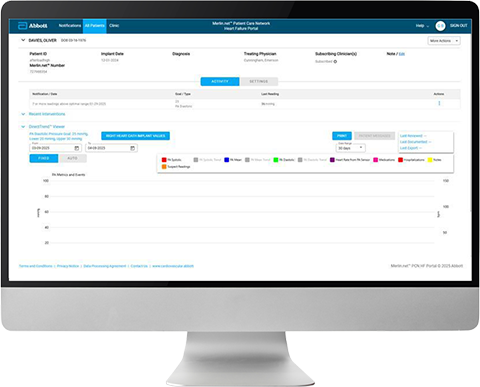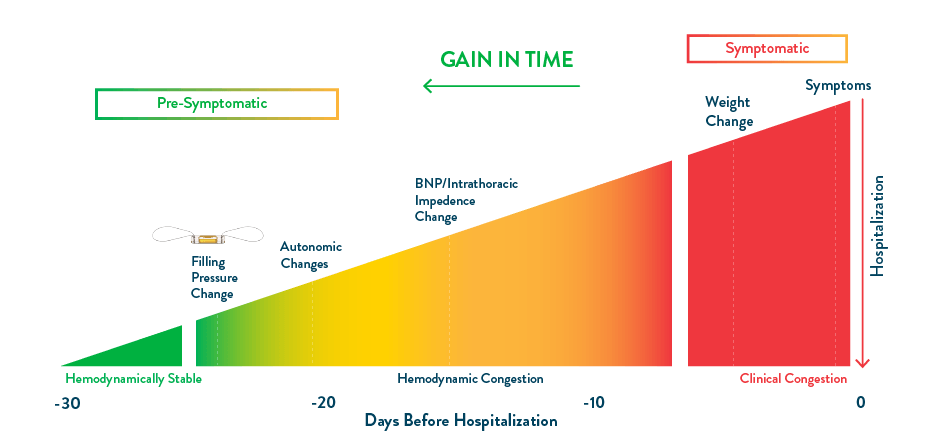Heart Failure management that’s always there.
So you don’t have to be.
You can’t always be there to manage your heart failure patients. The CardioMEMS™ HF System can give you regular updates on their pulmonary artery pressures to help you manage their treatment between office visits.1


Dynamic data-driven care to optimize GDMT
With the CardioMEMS HF System and hemodynamic data, you can optimize guideline-directed medical therapy (GDMT) to achieve better outcomes and reduce mortality.1-4
See if your heart failure patients are indicated for the CardioMEMS HF System with our Patient Indication Quiz
Instead of waiting for symptoms to present, detect worsening heart failure before an office visit or hospitalization is needed.
90% of heart failure hospitalizations are due to symptoms of pulmonary congestion.5 Increasing pulmonary artery pressures can indicate worsening heart failure, weeks before traditional markers like shortness of breath and weight gain. With remote access to precise hemodynamic data, you can make proactive GDMT adjustments that help prevent decompensation.1

Graph adapted from Adamson PB. Pathophysiology of the transition from chronic compensated and acute decompensated heart failure: new insights from continuous monitoring devices. Current Heart Failure Reports. 2009;6:287-292.
Management of Pulmonary Artery (PA) pressures can lead to reduced heart failure mortality2 and improved quality of life.1
Hemodynamic monitoring of PA pressure allows for proactive changes to medications that can reduce mortality for HFrEF patients by 25%.2
Small changes in PA pressures can make a difference in mortality.6 In the first 6 months post-implant of the CardioMEMS HF System, results showed:
Every 1 mmHG reduction in Diastolic PA Pressure (PAD) reduces mortality by 3%6

Patients with PA pressure reduction of ≥2 mmHg within the first 6 months post-implant have a decrease in mortality of 15% at 2 years.6

Using the CardioMEMS HF System for remote hemodynamic management, a randomized control trial (MONITOR-HF) was able to show:
44% reduction in heart failure hospitalizations1

7pt improvement in KCCQ scores1


The CardioMEMS HF System is the only PA pressure monitor proven to reduce overall PA pressures7-15
The CardioMEMS HF System has been proven safe, reliable,1 and has helped over 45,00016 patients and their care teams manage heart failure. Over 10 years of experience and three randomized control trials have shown that managing heart failure with CardioMEMS and reducing PA pressures can disrupt the progression of heart failure.1,7,16
Learn more about the CardioMEMS HF System
- Brugts JJ, Radhoe SP, Clephas PRD, et al. Remote haemodynamic monitoring of pulmonary artery pressures in patients with chronic heart failure (MONITOR-HF): a randomised clinical trial [published correction appears in The Lancet. 2023;401(10394):2112]. The Lancet. 2023;401(10394):2113-2123. doi:10.1016/S0140-6736(23)00923-6.
- Lindenfeld J, Costanzo MR, Zile MR, et al. Implantable Hemodynamic Monitors Improve Survival in Patients With Heart Failure and Reduced Ejection Fraction. J Am Coll Cardiol. 2024;83(6):682-694. doi:10.1016/j.jacc.2023.11.030.
- Givertz MM, Stevenson LW, Costanzo MR, et al; CHAMPION Trial Investigators. Pulmonary artery pressure-guided management of patients with heart failure and reduced ejection fraction. J Am Coll Cardiol. 2017;70(15):1875-1886. doi:10.1016/j.jacc.2017.08.010
- Abraham J, Bharmi R, Jonsson O, et al. Association of ambulatory hemodynamic monitoring of heart failure with clinical outcomes in a concurrent matched cohort analysis [published correction appears in JAMA Cardiol. 2019;4(6):601]. JAMA Cardiol. 2019;4(6):556-563. doi:10.1001/jamacardio.2019.1384
- Adams KF Jr, et al. Characteristics and outcomes of patients hospitalized for heart failure in the United States: rationale, design, and preliminary observations from the first 100,000 cases in the Acute Decompensated Heart Failure National Registry (ADHERE). Am Heart J 2005 Feb;149(2):209-16.
- Zile MR, Abraham WT, Stevenson LW, et al. Relationship Between Remote, Ambulatory Pulmonary Artery Pressures, and All-Cause Mortality in Patients With Chronic Heart Failure. Circ Heart Fail. Published online April 14, 2025. doi:10.1161/CIRCHEARTFAILURE.124.012754
- Abraham WT, Adamson PB, Bourge RC, et al. Wireless pulmonary artery haemodynamic monitoring in chronic heart failure: a randomized controlled trial. The Lancet. 2011;377(9766):658-66.
- Angermann C, Assmus B, Anker SD, et al. Pulmonary-arterypressure-guided therapy in ambulatory patients with symptomatic heart failure: the CardioMEMS European monitoring study for heart failure (MEMS-HF). European Journal of Heart Failure. 2020;22(10):1891-901.
- Shavelle D, Desai A, Abraham W, et al. Lower rates of heart failure and all-cause hospitalizations during pulmonary artery pressure-guided therapy for ambulatory heart failure. Circulation: Heart Failure. 2020;13(8):229- 38.
- Heywood JT, Zalawadiya S, Bourge RC, et al; CardioMEMS Post-Approval Study Investigators. Sustained reduction in pulmonary artery pressures and hospitalizations during 2 years of ambulatory monitoring. Journal of Cardiac Failure. 2023;29(1):56-66.
- Lindenfeld J, Zile MR, Desai AS, et al. Hemodynamic-guided management of heart failure (GUIDE-HF): a randomized controlled trial. The Lancet. 2021;398:991-1001.
- Mehra M, Costanzo MR, Zile M, et al; GUIDE-HF Trial Investigators. Primary results of the prospective single arm trial of hemodynamic-guided management of heart failure (GUIDE- HF). Presented at: Heart Failure Society of America (HFSA) Conference; October 2023; Cleveland, OH
- Heywood JT, Jermyn R, Shavelle D, et al. Impact of practice-based management of PA pressures in 2000 patients implanted with the CardioMEMS sensor. Circulation. 2017;135:1509-17.
- Cowie MR, Flett A, Cowburn P, et al. Real-world evidence in a national health service: results of the UK CardioMEMS HF System post-market study. ESC Heart Failure. 2021;9(1):48-56.
- Guichard JL, Bonno EL, Nassif ME, et al. Seated Pulmonary Artery Pressure Monitoring in Patients With Heart Failure: Results of thePROACTIVE-HF Trial. JACC: Heart Failure, 2022;S2213- 1779(24)00485- 2. Advance online publication. https://doi.org/10.1016/j.jchf.2024.05.017.
- Abbott Data on File
MAT-2505156 v2.0




